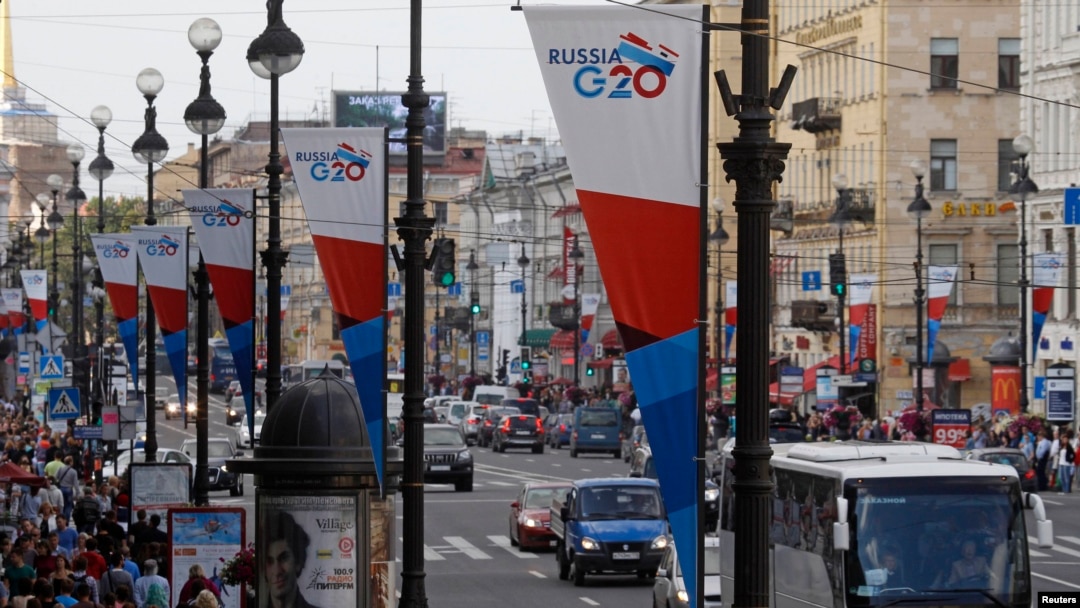When leaders of the G20 meet in St. Petersburg next month, they'll be greeted by a "vivid and dynamic" logo that pays tribute to the Russian avant-garde art of the early 20th century.
The design is based on the radical, geometric art of Kazimir Malevich and, according to the summit's official website, symbolizes "will, progress, transformation, a commitment to innovation...and bold ideas."
But in Moscow, Malevich isn't getting much respect these days. A luxury housing complex has sprung up over the site outside Moscow where his ashes were buried after his death in 1935.
Plowed Over
Malevich had requested that his ashes be buried near his favorite oak tree in a field near the village of Nemchinovka outside the capital.
But his remains found little rest in this idyllic setting. The simple marker erected at the spot was destroyed during World War II, as was Malevich's beloved oak tree.

During the 1950s, the land was given over to a collective farm and repeatedly plowed over. By the end of the decade, all memory of the location of one of Russia's most revered cultural figures had been lost.
Now the Romashkovo-2 elite housing complex has been built on the site. Authorities say the field had no protected status when construction on the project began.
Local history enthusiasts determined the exact location of the Malevich site and asked the Moscow Oblast Culture Department to freeze the project in June 2012, but nothing was done. The activists say they were able to secure some soil from the site before construction began, which will be interred at the site of a memorial to Malevich in the village of Nemchinovka.
The regional culture department said on August 27 that the owners of the complex have agreed to place a memorial plaque near the original site, which is located under a paved walkway near the entrance to a building, and to ensure public access to it.
Artistic Legacy
Malevich founded the Suprematist art movement around 1913. It was centered on "the supremacy of pure artistic feeling" through the use of pure geometric forms and a limited palette of colors. His ideas became widely known following an exhibition in St. Petersburg in 1915, at which his famous "Black Square" was first shown, together with 35 other suprematist works.
Toward the end of his life, Malevich and other avant-garde artists were harshly criticized as the regime of Josef Stalin imposed a heavily regimented socialist-realist style in art. Malevich's last great work was "Self-Portrait" (1933), which he painted realistically but signed subversively with just a black square.
The design is based on the radical, geometric art of Kazimir Malevich and, according to the summit's official website, symbolizes "will, progress, transformation, a commitment to innovation...and bold ideas."
But in Moscow, Malevich isn't getting much respect these days. A luxury housing complex has sprung up over the site outside Moscow where his ashes were buried after his death in 1935.
Plowed Over
Malevich had requested that his ashes be buried near his favorite oak tree in a field near the village of Nemchinovka outside the capital.
But his remains found little rest in this idyllic setting. The simple marker erected at the spot was destroyed during World War II, as was Malevich's beloved oak tree.

Kazimir Malevich in 1930
During the 1950s, the land was given over to a collective farm and repeatedly plowed over. By the end of the decade, all memory of the location of one of Russia's most revered cultural figures had been lost.
Now the Romashkovo-2 elite housing complex has been built on the site. Authorities say the field had no protected status when construction on the project began.
Local history enthusiasts determined the exact location of the Malevich site and asked the Moscow Oblast Culture Department to freeze the project in June 2012, but nothing was done. The activists say they were able to secure some soil from the site before construction began, which will be interred at the site of a memorial to Malevich in the village of Nemchinovka.
The regional culture department said on August 27 that the owners of the complex have agreed to place a memorial plaque near the original site, which is located under a paved walkway near the entrance to a building, and to ensure public access to it.
Artistic Legacy
Malevich founded the Suprematist art movement around 1913. It was centered on "the supremacy of pure artistic feeling" through the use of pure geometric forms and a limited palette of colors. His ideas became widely known following an exhibition in St. Petersburg in 1915, at which his famous "Black Square" was first shown, together with 35 other suprematist works.
Toward the end of his life, Malevich and other avant-garde artists were harshly criticized as the regime of Josef Stalin imposed a heavily regimented socialist-realist style in art. Malevich's last great work was "Self-Portrait" (1933), which he painted realistically but signed subversively with just a black square.


